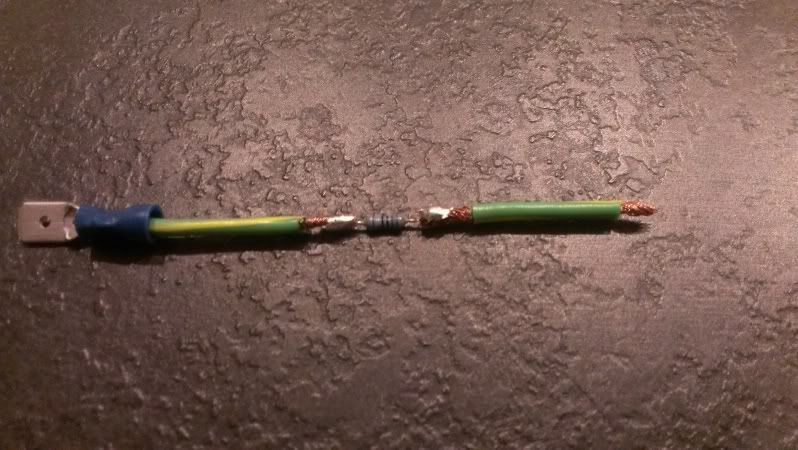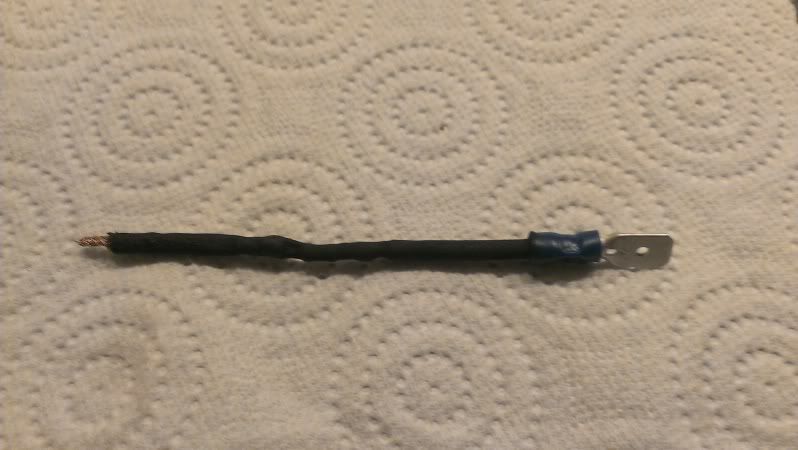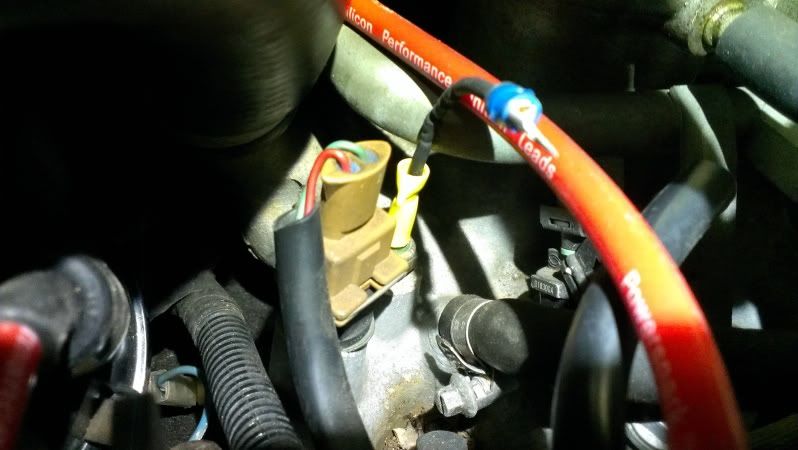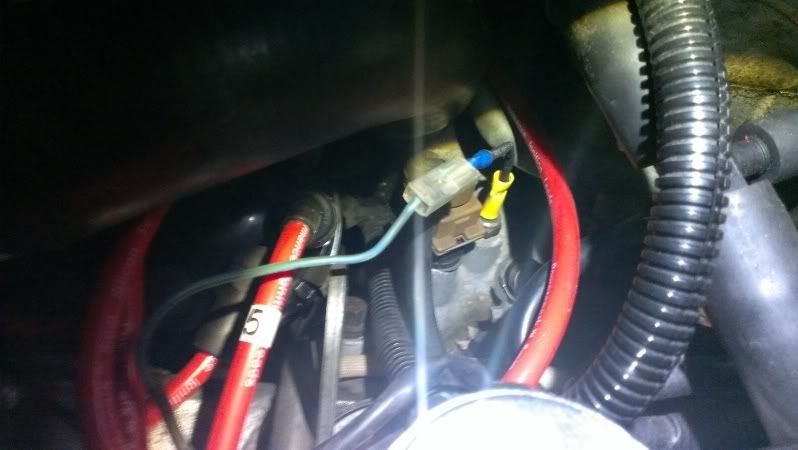Connection / Plug for Range Rover Temp Sender
Discussion
Hi Guys,
Just wondering - for those that have completed the Range Rover Temp Sender mod, what sort of plug did you use to connect to the sender?
I was planning on making up a lead with a crimp kit:
Femal Spade --> 170-Ohn resistor --> something to attach to range rover sender
But I'm not sure what the neatest way to do that is?
It just seems to be a nub sticking out, not a proper spade connector etc:

Cheers in advance!
Just wondering - for those that have completed the Range Rover Temp Sender mod, what sort of plug did you use to connect to the sender?
I was planning on making up a lead with a crimp kit:
Femal Spade --> 170-Ohn resistor --> something to attach to range rover sender
But I'm not sure what the neatest way to do that is?
It just seems to be a nub sticking out, not a proper spade connector etc:

Cheers in advance!
Ok, here's how I did it.
First I created a lead using a crimp tool, and soldering iron.
Spade - Wire - resistor - Wire

I went for a 160-Ohm resistor, as I've read suggestions of 150-Ohm and 170-Ohm in different places, so I decided to split the difference. At 60p a pop it's not gonna break the bank to replace it if its out a little.
Anyway, next some heat-shrink to neaten it up, and protect it:

Finally, I added a yellow inline crimp connector on the other end, squished it a little, and pushed it onto the range rover sender...

Then un-hooked the gauge connector from the cruddy TVR sender, and onto the spade connector of my adapter lead...

Finally I tucked the wire back down where it was before, under the dizzy... Job Done!
Hope that helps!
I'll report back how well it works after i give it a shot tomorrow.
First I created a lead using a crimp tool, and soldering iron.
Spade - Wire - resistor - Wire

I went for a 160-Ohm resistor, as I've read suggestions of 150-Ohm and 170-Ohm in different places, so I decided to split the difference. At 60p a pop it's not gonna break the bank to replace it if its out a little.
Anyway, next some heat-shrink to neaten it up, and protect it:

Finally, I added a yellow inline crimp connector on the other end, squished it a little, and pushed it onto the range rover sender...

Then un-hooked the gauge connector from the cruddy TVR sender, and onto the spade connector of my adapter lead...

Finally I tucked the wire back down where it was before, under the dizzy... Job Done!
Hope that helps!
I'll report back how well it works after i give it a shot tomorrow.
Malcster said:
So, it looks like it's reading around 10degrees to high, so I'd say you should go with a 170ohm resistor.
I'll make the change later in the week.
After a bit of trial and error, I think I have settled on an 180 Ohm metal-film resister (from Maplin).I'll make the change later in the week.
This shows the fans switching on at around 85-87 degrees.
Easy peasy fix, and it really makes a difference seeing the gauge move gradually and fairly accurately, as opposed to the eratic readings of the standard setup.
Malcster said:
After a bit of trial and error, I think I have settled on an 180 Ohm metal-film resister (from Maplin).
This shows the fans switching on at around 85-87 degrees.
Easy peasy fix, and it really makes a difference seeing the gauge move gradually and fairly accurately, as opposed to the eratic readings of the standard setup.
I did mine using a 170 Ohm resistor and got similar results, doesn't it warm up quickThis shows the fans switching on at around 85-87 degrees.
Easy peasy fix, and it really makes a difference seeing the gauge move gradually and fairly accurately, as opposed to the eratic readings of the standard setup.
Andav469 said:
I did mine using a 170 Ohm resistor and got similar results, doesn't it warm up quick
Where did you get your 170Ω resistor from? I can't see any at Maplin on their web. Mind you their web site is awful, it won't search for anything. I was thinking of a variable resistor as a few have used those, but can't one of those on their web either.If you get roverguage, there is no need for an unsightly variable resistor, you can trial and error until you have the correct one, with the previous work done on this mod, you have a close start already.
With a 170 Ohm resistor, my car sits at a guage reading of 82/85deg in normal driving with the fans kicking in at 90deg, whether its perfectly accurate or not I will be under no doubt that something is wrong if the reading climbs too high
With a 170 Ohm resistor, my car sits at a guage reading of 82/85deg in normal driving with the fans kicking in at 90deg, whether its perfectly accurate or not I will be under no doubt that something is wrong if the reading climbs too high
I have done some measurements with various resistors. The use of the range rover temperature sensor with the added resistor give a accurate reading at one temperature only. Below that temperature the gauge reads over the actual and above that temperature the gauge reads low.From my measurements
130 ohms is accurate at 87.5 degrees C
150 ohms is accurate at 84 degrees C
160 ohms is accurate at 80 degrees C
170 ohms is accurate at 77 degrees
It is not surprising the engine appears to warm up quickly with the mod. since the gauge give a higher reading than actual. More worrying is the gauge under reads at temperatures above the "accurate reading"
I have chosen a resistor that gives me a vertical needle on the gauge at "normal" running. Hence I can quickly see any changes from norm.
Hope this may help those considering the modification.
130 ohms is accurate at 87.5 degrees C
150 ohms is accurate at 84 degrees C
160 ohms is accurate at 80 degrees C
170 ohms is accurate at 77 degrees
It is not surprising the engine appears to warm up quickly with the mod. since the gauge give a higher reading than actual. More worrying is the gauge under reads at temperatures above the "accurate reading"
I have chosen a resistor that gives me a vertical needle on the gauge at "normal" running. Hence I can quickly see any changes from norm.
Hope this may help those considering the modification.
Andav469 said:
If you get roverguage, there is no need for an unsightly variable resistor, you can trial and error until you have the correct one, with the previous work done on this mod, you have a close start already.
With a 170 Ohm resistor, my car sits at a guage reading of 82/85deg in normal driving with the fans kicking in at 90deg, whether its perfectly accurate or not I will be under no doubt that something is wrong if the reading climbs too high
Regardless, it has to be more accurate than the current sender!With a 170 Ohm resistor, my car sits at a guage reading of 82/85deg in normal driving with the fans kicking in at 90deg, whether its perfectly accurate or not I will be under no doubt that something is wrong if the reading climbs too high
jeffwithaj said:
I have done some measurements with various resistors. The use of the range rover temperature sensor with the added resistor give a accurate reading at one temperature only. Below that temperature the gauge reads over the actual and above that temperature the gauge reads low.From my measurements
130 ohms is accurate at 87.5 degrees C
150 ohms is accurate at 84 degrees C
160 ohms is accurate at 80 degrees C
170 ohms is accurate at 77 degrees
It is not surprising the engine appears to warm up quickly with the mod. since the gauge give a higher reading than actual. More worrying is the gauge under reads at temperatures above the "accurate reading"
I have chosen a resistor that gives me a vertical needle on the gauge at "normal" running. Hence I can quickly see any changes from norm.
Hope this may help those considering the modification.
Does this happen with all senders or just the mod?130 ohms is accurate at 87.5 degrees C
150 ohms is accurate at 84 degrees C
160 ohms is accurate at 80 degrees C
170 ohms is accurate at 77 degrees
It is not surprising the engine appears to warm up quickly with the mod. since the gauge give a higher reading than actual. More worrying is the gauge under reads at temperatures above the "accurate reading"
I have chosen a resistor that gives me a vertical needle on the gauge at "normal" running. Hence I can quickly see any changes from norm.
Hope this may help those considering the modification.
chris1972 said:
jeffwithaj said:
I have done some measurements with various resistors. The use of the range rover temperature sensor with the added resistor give a accurate reading at one temperature only. Below that temperature the gauge reads over the actual and above that temperature the gauge reads low.From my measurements
130 ohms is accurate at 87.5 degrees C
150 ohms is accurate at 84 degrees C
160 ohms is accurate at 80 degrees C
170 ohms is accurate at 77 degrees
It is not surprising the engine appears to warm up quickly with the mod. since the gauge give a higher reading than actual. More worrying is the gauge under reads at temperatures above the "accurate reading"
I have chosen a resistor that gives me a vertical needle on the gauge at "normal" running. Hence I can quickly see any changes from norm.
Hope this may help those considering the modification.
Does this happen with all senders or just the mod?130 ohms is accurate at 87.5 degrees C
150 ohms is accurate at 84 degrees C
160 ohms is accurate at 80 degrees C
170 ohms is accurate at 77 degrees
It is not surprising the engine appears to warm up quickly with the mod. since the gauge give a higher reading than actual. More worrying is the gauge under reads at temperatures above the "accurate reading"
I have chosen a resistor that gives me a vertical needle on the gauge at "normal" running. Hence I can quickly see any changes from norm.
Hope this may help those considering the modification.
Gassing Station | Chimaera | Top of Page | What's New | My Stuff




